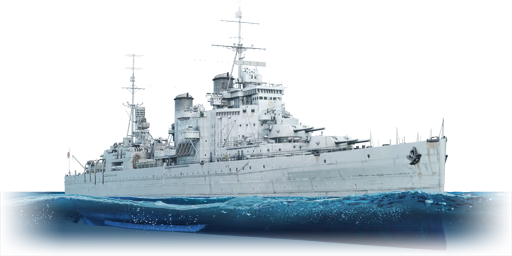

Bluewater Fleet
HMS London
IV
Rank
AB
5.7
RB
5.7
Battle rating
Great Britain
Research country
Heavy cruiser
Main role
30,000

Research
185,000

Purchase
General information
Specification
Armour
Citadel
25 / 88 / 35 mm
Main fire tower
25 / 25 / 25 mm
Hull
25 mm (steel)
Superstructure
8 mm (steel)
Number of sections
9
Displacement
13,315 t
Crew
793 persons
Max speed
Forward
60517051 km/h
Backward
25222922 km/h
Primary armament
4 × Turret — 2 × 8 inch/50 Mark VIII cannon
Ammunition
1,200 rounds
Reload
basic crew → aces
15.7 → 12 s
Vertical guidance
-3 / 70°
Turret Rotation Speed
Horizontal
65.165.1 °/s
Vertical
5.54.75.54.7 °/s
| Ammunition | Type | Armor penetration (mm) at a distance: | |||||
|---|---|---|---|---|---|---|---|
| 1000 m | 2500 m | 5000 m | 7500 m | 10000 m | 15000 m | ||
| HE | 62 | 62 | 62 | 62 | 62 | 62 | |
| SAPCBC | 270 | 238 | 193 | 158 | 129 | 91 | |
Secondary armament
4 × Turret — 2 × 4 inch/45 Mark XVI cannon
Ammunition
1,600 rounds
Reload
basic crew → aces
3.9 → 3 s
Vertical guidance
-10 / 80°
Turret Rotation Speed
Horizontal
7676 °/s
Vertical
108.5108.5 °/s
| Ammunition | Type | Armor penetration (mm) at a distance: | |||||
|---|---|---|---|---|---|---|---|
| 1000 m | 2500 m | 5000 m | 7500 m | 10000 m | 15000 m | ||
| HE | 20 | 20 | 20 | 20 | 20 | 20 | |
| SAP | 101 | 83 | 60 | 44 | 33 | 26 | |
| HE-TF | 20 | 20 | 20 | 20 | 20 | 20 | |
| HE-VT | 20 | 20 | 20 | 20 | 20 | 20 | |
Anti-aircraft armament
4 × Turret — 40 mm QF Mark VII gun
Ammunition
8,000 rounds
Belt capacity
4 rounds
Reload
basic crew → aces
0.5 → 0.4 s
Fire rate
160 shots/min
Vertical guidance
-6 / 90°
Turret Rotation Speed
Horizontal
3025.53025.5 °/s
Vertical
2420.42420.4 °/s
| Belt | Belt filling | Armor penetration (mm) at a distance: | |||||
|---|---|---|---|---|---|---|---|
| 10 m | 100 m | 500 m | 1000 m | 1500 m | 2000 m | ||
| HEFI-T | 6 | 6 | 5 | 5 | 4 | 4 | |
2 × Turret — 8 × 40 mm 2pdr QF Mk.VIII automatic cannon
Ammunition
35,840 rounds
Belt capacity
56 rounds
Reload
basic crew → aces
7.8 → 6 s
Fire rate
200 shots/min
Vertical guidance
-10 / 80°
Turret Rotation Speed
Horizontal
1512.81512.8 °/s
Vertical
1512.81512.8 °/s
| Belt | Belt filling | Armor penetration (mm) at a distance: | |||||
|---|---|---|---|---|---|---|---|
| 10 m | 100 m | 500 m | 1000 m | 1500 m | 2000 m | ||
| HEF | 4 | 4 | 3 | 3 | 3 | 3 | |
8 × Turret — 2 × 20 mm/70 Oerlikon Mark V autocannon
Ammunition
28,800 rounds
Belt capacity
60 rounds
Reload
basic crew → aces
10.4 → 8 s
Fire rate
450 shots/min
Vertical guidance
-5 / 85°
Turret Rotation Speed
Horizontal
60516051 °/s
Vertical
5042.55042.5 °/s
| Belt | Belt filling | Armor penetration (mm) at a distance: | |||||
|---|---|---|---|---|---|---|---|
| 10 m | 100 m | 500 m | 1000 m | 1500 m | 2000 m | ||
| HEF-T/AP-T | 34 | 32 | 26 | 21 | 18 | 16 | |
4 × Turret — 20 mm/70 Oerlikon Mk.II autocannon
Ammunition
7,200 rounds
Belt capacity
60 rounds
Reload
basic crew → aces
5.2 → 4 s
Fire rate
450 shots/min
Vertical guidance
-5 / 85°
Turret Rotation Speed
Horizontal
7563.87563.8 °/s
Vertical
6555.36555.3 °/s
| Belt | Belt filling | Armor penetration (mm) at a distance: | |||||
|---|---|---|---|---|---|---|---|
| 10 m | 100 m | 500 m | 1000 m | 1500 m | 2000 m | ||
| HEF-T/AP-T | 34 | 32 | 26 | 21 | 18 | 16 | |
Additional armament
Setup 1
8 × 533 mm Mk.IX wet-heater torpedo
Economy
Repair cost
Basic → Reference
AB
11,261 → 14,651 

RB
10,929 → 14,219 

Crew training
53,000 

Experts
185,000 

Aces
1,100 

Research Aces
520,000 

Reward multiplier
AB / RB
450 / 600 % 

172 % 

Total cost of modifications
54,900 

100,600 

Talisman cost
1,700 

Research order:
Seakeeping |
|---|
Unsinkability | |
|---|---|
Firepower | ||
|---|---|---|
Rating by players
You must play more than 3 battles for the last week and more than 10 battles in a vehicle to rate it.
Like:
5
Armor protection:
Not enough ratings
Survivability:
Not enough ratings
Mobility:
Not enough ratings
Armament:
Not enough ratings
Balance:
Not enough ratings
Tips & Tricks
This space is currently empty
Do you know any interesting vehicle features?
Loading...
No articles about this vehicle yet
Become the first author and get rewards!
Write a guide, tell about interesting historical facts, make a tutorial or simply an interesting post.
No more content